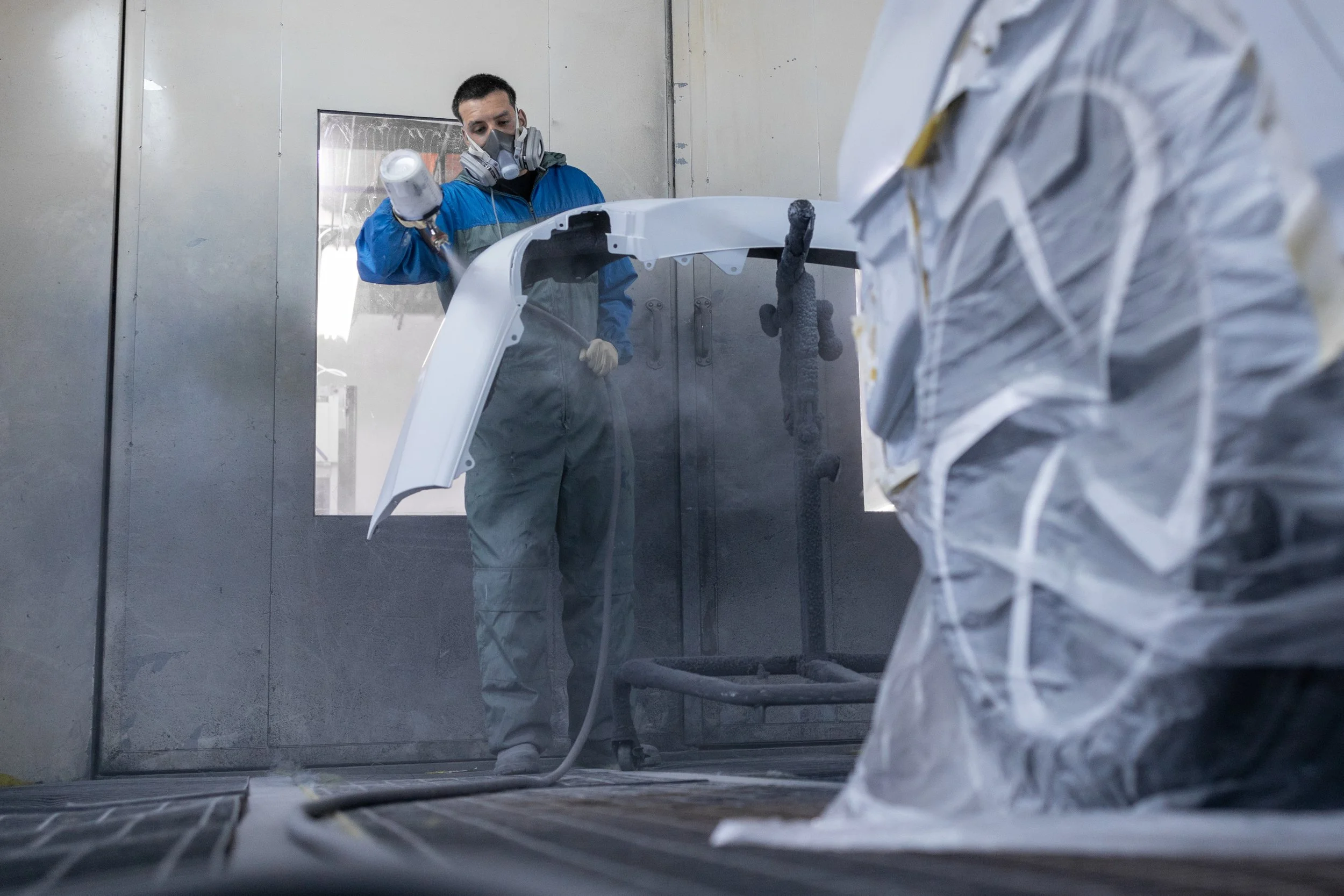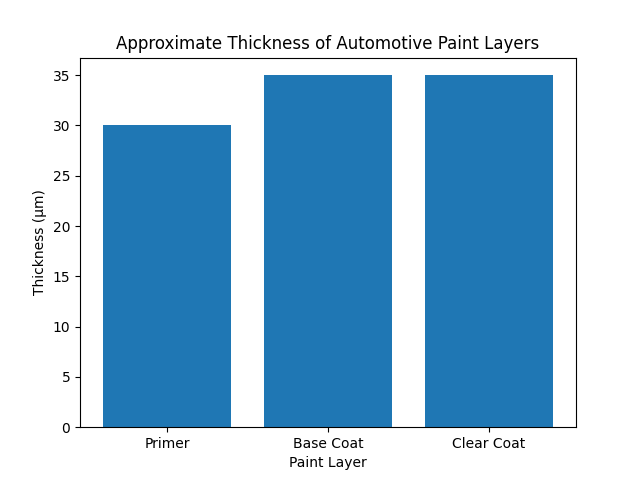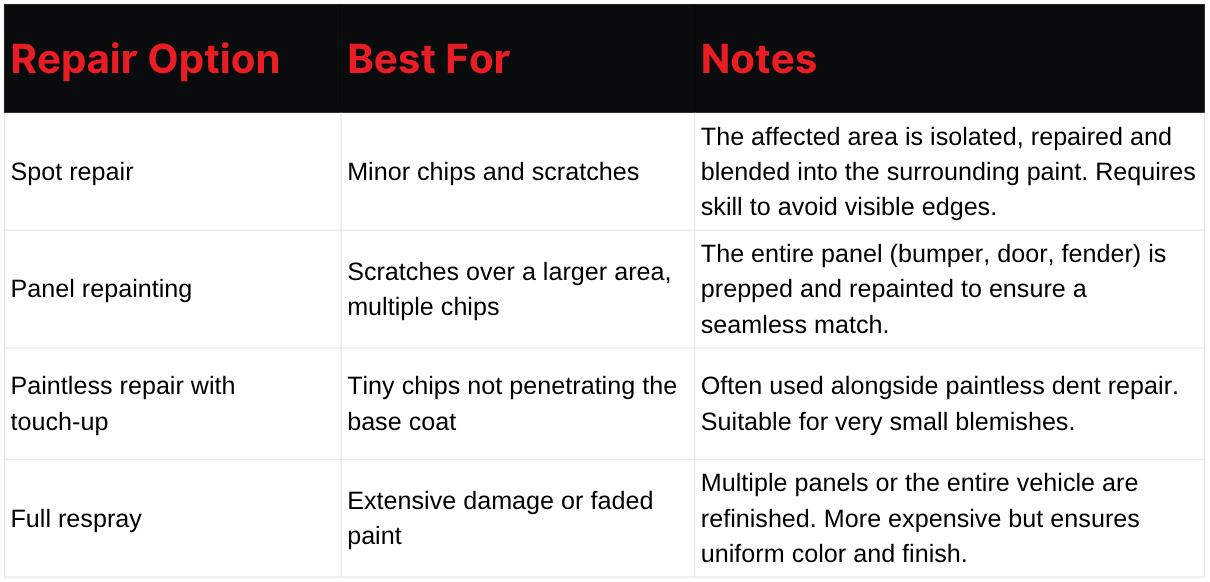Paint Repair After an Accident: How to Restore Your Vehicle’s Value
When you glance at your car, you’re mostly looking at paint. That glossy finish isn’t just for show; it forms a protective barrier between the steel or aluminum body and the elements. Modern automotive paint systems consist of several layers. The car body is first dipped into an electrocoat primer bath that covers the metal surfaces and forms a corrosion‑resistant epoxy‑urethane film. A primer‑surfacer is then applied to smooth the surface, provide opacity and protect the electrocoat from ultraviolet (UV) light. Next comes the basecoat containing pigments that produce color. Finally, a clearcoat layer provides the ultimate protection and appearance, shielding the underlying paint from weather and UV exposure (paint.org). Together, these layers typically measure about 4–6 mils (0.10–0.15 mm) thickrts.i-car.com, with the clearcoat accounting for roughly 2 mils (0.05 mm) (rts.i-car.com).
Accidents, however small, can penetrate these layers. A chip or scratch may look harmless, but it exposes metal to moisture and road salt, which starts the rusting process. Restoring damaged paint keeps rust at bay and preserves your vehicle’s appearance and value. In the sections that follow, you’ll learn why timely repairs are important, what the repair process looks like and how to choose the right option for your situation.
Why Repairing Paint Damage Matters
Minor paint damage isn’t just cosmetic. Here’s why you shouldn’t ignore it:
Corrosion protection: Modern electrocoat primers and primer‑surfacers are designed to cover nearly all metal surfaces and provide excellent corrosion protection (paint.org). If a scratch breaks through these layers, water and salt can reach the metal and cause rust.
Resale value: A well‑maintained exterior signals that the vehicle has been cared for. Visible chips, mismatched panels or rust patches can significantly reduce trade‑in or resale value.
Avoiding larger repairs: Rust spreads under paint. Fixing a small chip now is far cheaper than repairing a rusty panel later.
Together, these factors mean that a quick, professional repair protects both the appearance and the investment you’ve made in your car.
Understanding the Paint Repair Process
Knowing what happens in the body shop demystifies the repair and helps you make informed decisions. Here are the typical steps, with short explanations for each:
Damage assessment – Technicians examine the scratch or chip to see if only the surface paint is affected or if there’s underlying dent or structural damage. This determines whether a simple touch‑up or a larger repair is needed.
Color matching – Using your vehicle’s manufacturer paint code and digital color‑matching tools, the shop mixes paint that matches the original finish. Matching the color correctly prevents obvious touch‑up spots.
Surface preparation – Technicians clean and sand the damaged area and remove any rust. Proper surface preparation ensures that the primer‑surfacer and subsequent coatings adhere properly; without it the finish can fail prematurely.
Priming and filling – A primer‑surfacer coat smooths the surface, provides opacity and protects the underlying electrocoat from UV degradation. If there are small dents, a thin layer of body filler or glazing putty is applied and sanded smooth.
Base coat application – The color‑matched basecoat is sprayed in thin layers; this layer contains pigments that provide the correct color and depth. The paint is allowed to flash (partially dry) between coats.
Clear coat application – The clearcoat is formulated to enhance appearance and provide the ultimate protection for the coating system below. Proper curing between layers ensures durability.
Finishing and inspection – After the paint cures, technicians polish the repaired area to blend with adjacent panels. A final inspection verifies the color match and surface quality.
Visualising Paint Layers
It helps to see what goes into a factory finish. The bar chart below illustrates a typical distribution of paint layers by thickness. While actual values vary by manufacturer, the entire paint system typically measures about 4–6 mils (roughly 100–150 µm) thick.
Each layer plays an important role; if one is compromised, the whole system is weakened. That’s why a professional repair restores the primer, base coat and clear coat rather than simply brushing on touch‑up paint.
Common Mistakes to Avoid
Many drivers underestimate paint damage or choose shortcuts that can cause bigger problems. Avoid these pitfalls:
Ignoring small chips – Even tiny chips allow moisture to creep under the paint and start rusting. Addressing them promptly prevents corrosion from spreading.
DIY fixes with mismatched paint – Off‑the‑shelf touch‑up kits rarely match perfectly and often lack proper primer and clear coat. Poor color matches and missing layers can make the repair more noticeable and fail prematurely.
Choosing the cheapest option – Low‑budget shops may use inferior materials or skip steps like priming and clear coating, leading to premature peeling or fading. A quality repair costs more up front but saves money over time.
Being aware of these mistakes helps you make better decisions and avoid frustration down the road.
Choosing the Right Repair Option
Different types of damage call for different solutions. Here’s a quick guide:
After assessing the damage, consult with a trusted shop to determine which option balances cost, quality and longevity.
What Drivers Should Expect
Before you drop your car off for repairs, it’s helpful to know what lies ahead:
Timeline: Simple touch‑ups often take one to two days. Larger panel repairs requiring multiple coats and curing can take several days to a week. Full resprays and complex color matches may take longer. Quality takes time.
Cost: Prices vary by damage size, paint type (solid, metallic or pearl) and labor rates. Small repairs may cost a few hundred dollars, while full panel refinishing can run into the thousands. Always request a written estimate.
Insurance: If the damage is part of a covered claim, your policy should pay for repairs after your deductible. California law allows you to choose any shop; insurers cannot force you to use their preferred facilities.
Virtual estimates: Many shops offer virtual estimate tools. Upload photos of the damage and basic vehicle info to get a preliminary quote before scheduling a visit.
By knowing what to expect, you can plan around your repair and avoid surprises.
Working With a Professional Shop
Professional body shops do more than cover up damage. They understand that automotive finishes comprise multiple layers—an electrocoat primer, primer‑surfacer, basecoat and clearcoat—that work together to protect the car body paint.org. Proper equipment, trained technicians and a controlled spray booth are essential for a durable, factory‑level finish.
When comparing shops, look for the following:
Certifications and training – OEM certifications and ongoing training ensure technicians stay current on modern materials and repair methods.
Quality materials – Ask if the shop uses OEM‑approved paints and primers; these products match your car’s original finish and last longer.
Warranty coverage – Reputable shops guarantee their paint work. A written warranty offers peace of mind if issues arise.
Customer reviews – Positive feedback from other drivers can provide insight into quality and service.
Choosing a professional shop protects your vehicle and ensures the repair will stand the test of time.
How Prestige Bodyworks Handles Paint Repair
Once you understand the process, it’s clear that expertise matters. Prestige Bodyworks in Oxnard adheres to manufacturer specifications for every repair. Their technicians use OEM‑quality paints and materials, ensuring the repaired area matches the original finish. Prestige participates in Direct Repair Programs with major insurers like USAA and State Farm, which streamlines the claims process for you. They serve drivers from Oxnard, Ventura and Camarillo, and their team is certified to work on brands like Tesla and BMW. Whether you need a small scratch fixed or a full panel refinished, Prestige’s attention to detail means your car will look like new when it leaves the shop.
Conclusion
Paint damage after an accident isn’t just about looks. Protecting your car’s body from corrosion, maintaining resale value and preventing larger repairs all depend on addressing chips and scratches promptly. Modern automotive paint systems are complex, and a professional repair restores each layer—electrocoat primer, primer‑surfacer, basecoat and clearcoat—to factory standards. By understanding the process, avoiding common mistakes and choosing a reputable shop, you safeguard your investment and ensure your vehicle remains safe and attractive.
Contact Prestige Bodyworks for certified repairs done right the first time.




